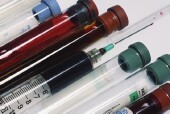
SUNDAY, Dec. 13 (HealthDay News) — Miniature “nanosensors” can detect early signs of cancer in everyday blood samples taken from patients, researchers report.
The sensors hunted for and picked up biomarkers for prostate and breast cancers. Study co-author Mark Reed, associate director of the Yale Institute for Nanoscience and Quantum Engineering in New Haven, Conn., said the technology “can generally be applied to many other types of biomarkers.”
The ultimate, hoped-for outcome is quick, easy and low-cost tests that can be done in a doctor’s office to detect cancer before it becomes troublesome.
“From a personalized medicine point of view, you could take a spot of blood from a fingerprick and get results within minutes. It would be simple, stable and relatively inexpensive,” said William C. Phelps, program director of Translational and Preclinical Cancer Research at the American Cancer Society.
“There’s a crying need for things like this in lung cancer, where you would want to be able to detect biomarkers in a sputum sample, and pancreatic and ovarian cancer,” Phelps said. “You can’t really detect these early, so they’re very hard to treat,” he noted.
“You want to detect a particular protein in the blood that’s indicative of disease and you want to detect it early with high specificity and accuracy. You don’t want false-positives or false-negatives,” Phelps added.
Although the technology has yet to make it to the doctor’s office, it is revolutionary in more than one way.
Previous technologies work in much the same way, but can only detect biomarkers in purified solutions, not the real thing — meaning fluid samples from patients.
“The real achievement here was demonstrating this with blood, which was a longstanding goal,” Reed explained. “It could not be done before because blood has too much salt and other stuff in it, which prevents this type of sensing. We developed a method to filtrate out specifically what we want to detect.”
Only small amounts of blood were needed and the process took all of 20 minutes.
The study findings were published online Dec. 13 in the journal Nature Nanotechnology.
Nanotechnology is able to work at the sub-cellular level, said Yoed Rabin, associate professor of biothermal technology at Carnegie Mellon University in Pittsburgh.
These particular nanosensors in the new study, Reed said, “sense the absorption of molecules on its surface and give an electrical signal output.”
Much of these innovations are a direct outgrowth of the Human Genome Project, which identified and sequenced the entire human genome of about 30,000 genes, Phelps said.
Although not too many cancer biomarkers have been identified, the Human Genome Project should yield many more.
“This gives a wonderful catalogue and characterization of cells and cancer cells that could be markers, so the biological underpinnings to do this are well in hand,” Phelps said. “If you find a protein, you can go back and say this protein is connected to this gene and this gene is more often expressed in cancer.”
More information
To learn more, visit the National Nanotechnology Initiative.

